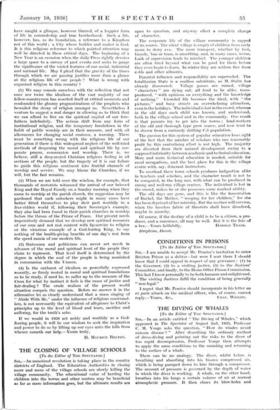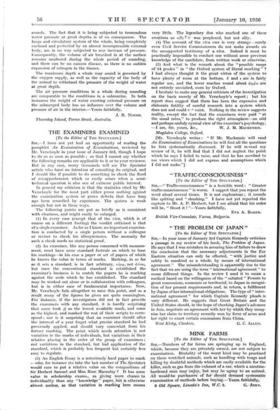THE DIVING OF WHALES
[To the Editor of TILE SPECTATOR.] SIR,—In an article entitled " The Diving of Whales," which appeared in The Spectator of August 2nd, 1935, Professor C. M. Yonge asks the question, " How do whales avoid caisson disease " After describing the ordinary method of dress-diving and pointing out the risks to the diver of too rapid decompression, Professor Yonge then attempts to apply the same conditions to the sounding and returning to the surface of a whale.
There can be no analogy. The diver, whilst below, is breathing and absorbing into his tissues compressed air, which is being pumped down to him through a compressor. The amount of pressure is governed by the depth of water in which the diver is working. A whale, on the other hand, breathes into his lungs a certain volume of air at normal atmospheric pressure. It then closes its blow-holes and
sounds. The fact that it is being subjected to tremendous water pressure at great depths is of no consequence. The lungs and circulatory system of the whale, being completely enclosed and protected by an almost incompressible external body, are in no way subjected to any increase of pressure. Consequently, the volume of air breathed in at the surface remains unaltered during the whole period of sounding, and there can be no caisson disease, as there is no sudden expansion of nitrogen in the tissues.
The maximum depth a whale may sound is governed by the oxygen supply, as well as the capacity of the body of the animal to withstand the pressure of the weight of water at great depth.
The air pressure conditions in a whale during sounding are comparable to the conditions in a submarine. In both instances the weight of water exerting external pressure on the submerged body has no influence over the volume and pressure of air in the interior.—Yours faithfully, Thursday Island, Torres Strait, Australia. J. H. Nrarmo.











































 Previous page
Previous page